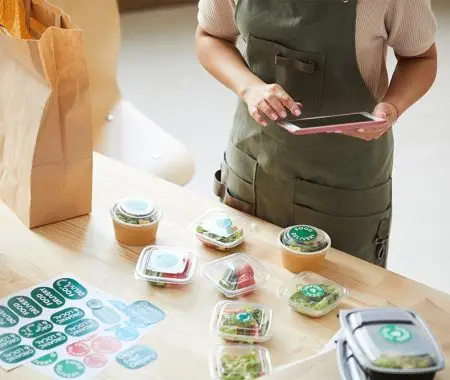When it comes to food labeling, there are a few things that F&B businesses need to keep in mind. Labels must be clear and concise, providing all the necessary information for the consumer, while remaining fully compliant with local market regulations. In addition, labels should be visually appealing to encourage purchases — and above all, they must always be accurate and truthful.
The FDA has strict regulations for food labeling, but navigating these rules doesn’t have to be overwhelming.
This blog will explore different types of food labels across global markets and show how choosing the right format can boost both compliance and marketing impact.
With tools like Food Label Maker, you can easily create a free nutrition label to ensure your product meets every requirement, or view our pricing plans to find the right package for your business.
See How FoodLabelMaker Can Help You
What are the different types of food labels that can be found on products in stores and restaurants?
Here is a brief overview of the most common types:
- FDA Standard Label: This is the required Nutrition Facts Label for most packaged foods in the U.S., regulated under 21 CFR 101.9. It must include standardized elements such as serving size, calories, nutrients (e.g., fat, sodium, carbs, protein, added sugars), an ingredient list, and major allergen statements as mandated by the Food Allergen Labeling and Consumer Protection Act (FALCPA). Manufacturer name and contact info are also required.
- Tabular Format Nutrition Facts Label: “Tabular” format is not a separate type of label but a permitted layout variation when space on the package is limited. It still carries all the same required information as a standard label but is formatted horizontally rather than vertically. It is not an entirely different label type.
- Linear Format Nutrition Facts Label: This is a simplified label format allowed when there is very limited space on small packages. It still must list required nutrient information in a line-by-line format, not just ingredients. Ingredient lists are separate and also required by FDA.
- Dual Column Nutrition Facts Label: This format is required for products that can be consumed in one sitting or multiple sittings (e.g., a pint of ice cream). The first column shows nutrient info per serving, and the second column shows info per package or unit.
- UK Traffic Light Label: This is a voluntary front-of-pack scheme used in the UK. It assigns color codes to fat, saturated fat, sugars, and salt based on 100g/ml thresholds. Green = low, Amber = medium, Red = high. It helps consumers make quick comparisons, but participation by manufacturers is optional.
- EU Standard Label: Under Regulation (EU) 1169/2011, most prepackaged foods must display standardized nutrition information per 100g/ml, plus an ingredient list and allergen declarations. Nutri-Score is voluntary and not mandatory EU-wide, though certain countries like France and Germany strongly promote it. It is incorrect to state that every EU label must have a Nutri-Score.
- CFIA-Compliant Label: In Canada, nutrition labels must follow Health Canada’s Nutrition Facts Table (NFT) requirements. Labels must be bilingual (English and French), use specified fonts and formats, and list mandatory nutrients such as calories, fat, sodium, and sugars.
- Australia & New Zealand Label: Labels must comply with FSANZ Code requirements, which include an ingredient list, allergen declarations, and a Nutrition Information Panel (NIP). Health star ratings are voluntary but common.
- Restaurant or Menu Labeling: In the U.S., restaurant nutrition labeling is regulated for chains with 20 or more locations, under the Affordable Care Act (ACA). Calorie counts must be displayed on menus, and other nutrients must be available upon request. For smaller restaurants, simplified labels may be provided voluntarily.
Food Label Maker offers nine different nutrition facts layouts and four different languages: English, French, Arabic, and Spanish; with many more formats and languages planned to be added along the way.
It can be tough to keep track of all the different food labels out there. But it’s important to understand what each one means, to make the best choice for your product label.
So, what’s the best food label? The truth is there’s no one-size-fits-all solution. The most effective label format depends on your market, target audience, and the type of product you’re selling.
If you want to make your food packaging more informative and engaging for consumers, consider formats like traffic light labels or restaurant labels. And if you’re unsure which label type is right for your product, the standard FDA label is always a safe and compliant choice.
To simplify the process, you can create a free nutrition label using Food Label Maker or view our pricing plans to find the perfect solution for your business. With the right tools, creating accurate, compliant, and attractive food labels has never been easier.



